
In Lewis Carroll's Through the Looking-Glass, and What Alice Found There (1871), the heroine enters an imaginary, alternative universe by climbing through a mirror in her house. In this world, a reflected version of her home, everything is topsy-turvy and back-to-front. Like Alice's make-believe world, the China mirrored in the fashions in this exhibition is wrapped in invention and imagination. Stylistically, they belong to the practice of Orientalism, which since the publication of Edward Said's seminal treatise on the subject in 1978 has taken on negative connotations of Western supremacy and segregation. At its core, Said interprets Orientalism as a Eurocentric worldview that essentializes Eastern peoples and cultures as a monolithic other.
While neither discounting nor discrediting the issue of the representation of "subordinated otherness" outlined by Said, this exhibition attempts to propose a less politicized and more positivistic examination of Orientalism as a site of infinite and unbridled creativity. Through careful juxtapositions of Western fashions and Chinese costumes and decorative arts, it presents a rethinking of Orientalism as an appreciative cultural response by the West to its encounters with the East. The ensuing dialogues are not only mutually enlivening and enlightening, but they also encourage new aesthetic interpretations and broader cultural understandings.
As if by magic, the distance between East and West, spanning perspectives that are often perceived as monolithic and diametrically opposed, diminishes. So, too, does the association of the East with the natural and the authentic and the West with the cultural and the simulacrum. As these binaries dissolve and disintegrate, what emerges is an active, dynamic two-way conversation, a liberating force of cross-cultural communication and representation.
Cinema often serves as a conduit for this reciprocal exchange. Film is frequently the first lens through which Western designers encounter Chinese imagery, and this exhibition explores the impact of movies in shaping their fantasies. Through the work of Chinese directors—especially the Fifth Generation, including Chen Kaige, Zhang Yimou, and Tian Zhuangzhuang—the show also addresses China's role in shaping its own self-image. At times borrowing from Orientalist tropes, Chinese directors have perpetuated some of the misperceptions that had shaped Western fantasies of China. Aided by such cinematic representations, the comparisons and conversations in the exhibition reimagine the relationship between East and West not as one-sided mimicry but rather as a layered series of enfolded exchanges.
Emperor to Citizen: Galleries 980, 981, and 132
When Western designers are inspired by China's long and rich history, they invariably gravitate toward the Qing dynasty (1644–1911), the Republic of China (1912–49), and the People's Republic of China (1949–present), and respectively, the Manchu robe, the modern qipao, and the Zhongshan suit (after Sun Yat-sen, but more commonly known in the West as the Mao suit, after Mao Zedong). For designers, these garments serve not only as a kind of shorthand for China and the shifting social and political identities of its peoples, but also as sartorial symbols that allow Western designers to contemplate the idea of a radically different society from their own.
By integrating references to the Manchu robe, qipao, and Mao suit into their fashions, designers engage in a form of romantic Orientalism that emphasizes the role of dress as a performative act. Their clothes—like those depicted in eighteenth- and nineteenth-century Orientalist paintings—allow the wearer to fabricate an alternative identity through a process of cultural displacement. While some may perceive an implicit power imbalance in such costuming, designers are driven less by the logic of politics than by that of fashion, which is typically more concerned with an aesthetic of surfaces rather than the specifics of cultural context.
Manchu Robe

In terms of the Manchu robe, Western designers usually focus their creative impulses toward the formal (official) and semiformal (festive) costumes of the imperial court in all of their imagistic splendor and richness. Bats, clouds, ocean waves, mountain peaks, and in particular, dragons are presented as meditations on the spectacle of imperial authority. Most of the robes in this gallery—several of which belong to the Palace Museum in Beijing—were worn by Chinese emperors, a fact indicated by the twelve imperial symbols woven into or embroidered onto their designs to highlight the rulers' virtues and abilities: sun with three-legged bird; moon with a ''jade hare'' grinding medicine; constellation of three stars, which, like the sun and moon, signify enlightenment; mountains to signify grace and stability; axe to signify determination; Fu symbol (two bow-shaped signs) to signify collaboration; pair of ascending and descending dragons to signify adaptability; pheasant to symbolize literary elegance; pair of sacrificial vessels painted with a tiger and a long-tailed monkey to signify courage and wisdom; waterweed to signify flexibility; flame to signify righteousness; and grain to signify fertility and prosperity.
In a surrealist act of displacement, the British milliner Stephen Jones, commissioned by the Museum to create the headpieces in the exhibition, has relocated these symbols, whose placement on the imperial costumes of the emperor was governed by strict rules, to the head, where they appear as three-dimensional sculptural forms.
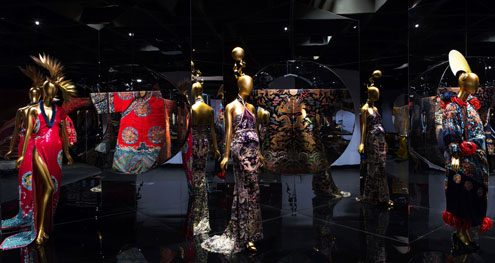
Film and Music Presented in This Gallery
The Last Emperor, 1987
Directed by Bernardo Bertolucci
Columbia Pictures
Courtesy of Recorded Picture Company
"Open the Door," from The Last Emperor film score
Composed and performed by Ryuichi Sakamoto
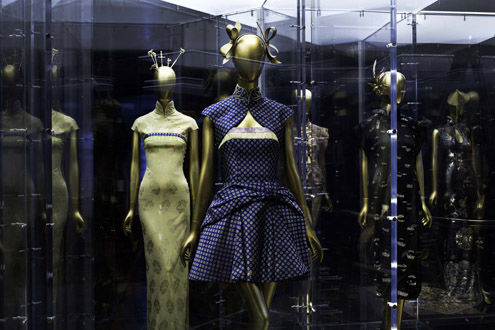
Hu Die (Butterfly Wu)
In the period between the two world wars, film actresses in Shanghai, known as the Hollywood of the East, were in the vanguard of fashion. Through their images on screen as well as in lifestyle magazines, they led new trends in the modern qipao. In the 1930s, the most eminent actress was Hu Die (Butterfly Wu), whose qipaos are on view here. Elected the Queen of Cinema after a nationwide poll by the Star Daily newspaper in 1933, she won favor with her on-screen depictions of virtuous women and her off-screen persona of ladylike sophistication (although her affairs with renowned politicians sometimes threatened her wholesome reputation). In the West, Hu Die became an embodiment of Chinese femininity. Her photograph appeared in a 1929 issue of American Vogue as the example of modern "Chinese elegance."
Film and Music Presented in This Gallery
The Hand from Eros, 2004
Directed by Wong Kar Wai
Warner Independent Pictures
Courtesy of Block 2 Pictures Inc.
© 2004 Block 2 Pictures Inc. All rights reserved.
The Goddess, 1934
Directed by Wu Yonggang
Lianhua Film Company
Courtesy of China Film Archive
In the Mood for Love, 2000
Directed by Wong Kar Wai
Block 2 Pictures
Courtesy of Block 2 Pictures Inc.
© 2000 Block 2 Pictures Inc. All rights reserved.
Lust, Caution, 2007
Directed by Ang Lee
Focus Features
Courtesy of EDKO FILMS LIMITED
The World of Suzie Wong, 1960
Directed by Richard Quine
Paramount Pictures
Courtesy of Paramount Pictures
Incidental music from The Goddess
Composed and performed by Kevin Purrone
"Ella Giammai m'amo," from Don Carlos
Composed by Giuseppe Verdi
"The Ding Dong Song"
Composed by Lionel Bart; performed by Tsai Chin
"Concerto Alevta"
Composed and performed by Peer Raben
"Quizas Quizas Quizas"
Written by Osvaldo Farrés; performed by Nat King Cole
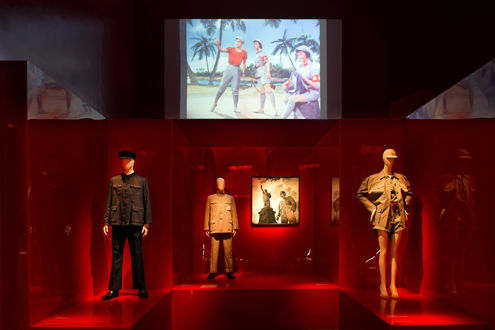
People's Republic of China
The Zhongshan suit, or Mao suit as it is more commonly known in the West, remains a powerful sartorial signifier of China, despite the fact that it began disappearing from the wardrobes of most Chinese men and women, aside from government officials, in the early 1990s. For many Western designers, the appeal of the Mao suit rests in its principled practicality and functionalism.
Its uniformity implies an idealism and utopianism reflected in its seemingly liberating obfuscation of class and gender distinctions. During the late 1960s, a time of international political and cultural upheaval, the Mao suit in the West became a symbol of an anticapitalist proletariat. In Europe, it was embraced enthusiastically by the left-leaning intelligentsia specifically for a countercultural and antiestablishment effect.
Film and Music Presented in This Gallery
Chung Kuo: Cina, 1972
Directed by Michelangelo Antonioni
RAI Radiotelevisione Italiana
Courtesy of RAI TECHE
In the Heat of the Sun, 1994
Directed by Jiang Wen Golden
Harvest Company
Orange Sky Golden Harvest Entertainment Group
The Red Detachment of Women, 1970
Directed by Fu Jie and Pan Wenzhan
Beijing Film Studio
Courtesy of China Film Archive
"I Love Beijing Tianamen"
Composed by Jin Yueqin with lyrics by Jin Guolin; performed by Children's Choir of China
"Katyusha"
Composed by Matvei Blanter with lyrics by Mikhail Isakovsky; performed by Alexandrov Ensemble
Incidental music from The Red Detachment of Women
Empire of Signs: Galleries 206–218
This exhibition is not about China per se but about a collective fantasy of China. It is about cultural interaction, the circuits of exchange through which certain images and objects have migrated across geographic boundaries. Moreover, it points to the aesthetic importance of exploring all the products of our cultural fantasies. As opposed to censoring or disregarding depictions of other cultures that are not entirely accurate, it advocates studying these representations on their own terms, appreciating them from the outset as having been infused with creativity, and discovering in this complex dialogue of elided meanings, a unified language of shared signs. For the designers in this exhibition, China represents a land of free-floating symbols, a land where postmodernity finds its natural expression. Like Marco Polo or Gulliver, they are itinerant travelers to another country, reflecting on its artistic and cultural traditions as an exoticized extension of their own, mythical, fictional, and fantastical, their China exists only in their imaginations. When quoting Chinese artifacts or costumes, these designers are not reproducing literal copies or accurate facsimiles. Rather, they reinterpret them through seemingly paradoxical postmodern constructions.
Anna May Wong
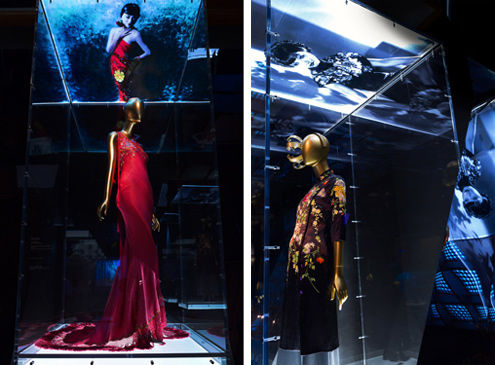
In terms of shaping Western fantasies of China, no figure has had a greater impact on fashion than the Chinese-American actress Anna May Wong. Born in Los Angeles in 1905 as Huang Liushuang ("yellow willow frost"), she was fated to play opposing stereotypes of the Enigmatic Oriental, namely the docile, obedient, submissive Lotus Flower and the wily, predatory, calculating Dragon Lady. Limited by race and social norms in America and constrained by one-dimensional caricatures in Hollywood, she moved to Europe, where the artistic avant-garde embraced her as a symbol of modernity, The artists Marianne Brandt and Edward Steichen found a muse in Anna May Wong, as did the theorist Walter Benjamin, who in a 1928 essay describes her in a richly evocative manner: "May Wong the name sounds colorfully margined, packed like marrow-bone yet light like tiny sticks that unfold to become a moon-filled, fragranceless blossom in a cup of tea." Benjamin, like the designers in this gallery, enwraps Anna May Wong in Western allusions and associations. In so doing, he unearths latent empathies between the two cultures, which the fashions on display here extend through their creative liberties.
Film and Music Presented in This Gallery
Daughter of the Dragon, 1931
Directed by Lloyd Corrigan
Paramount Pictures
Courtesy of Universal Studios Licensing LLC
Limehouse Blues, 1934
Directed by Alexander Hall Paramount Pictures
UCLA Film & Television Archive
Piccadilly, 1929
Directed by E. A. Dupont British International Pictures
Courtesy of Milestone Film & Video and British Film Institute
Shanghai Express, 1932
Directed by Josef von Sternberg Paramount Pictures
Courtesy of Universal Studios Licensing LLC
The Toll of the Sea, 1922
Directed by Chester M. Franklin
Metro Pictures Corporation
UCLA Film & Television Archive
"These Foolish Things"
Composed by Harry Link, Holt Marvell, Jack Strachey; performed by Billie Holiday
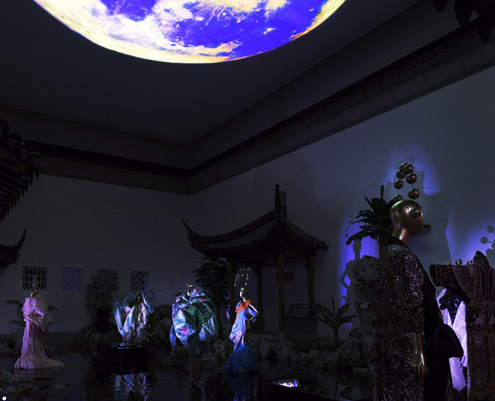
Moon in the Water
The exhibition's subtitle, "Through the Looking Glass," translates into Chinese as "Moon in the Water," a phrase that alludes to Buddhism. Like "Flower in the Mirror," it suggests something that cannot be grasped, and has both positive and negative connotations. When used to describe a beautiful object, "moon in the water" can refer to a quality of perfection that is either so elusive and mysterious that the item becomes transcendent or so illusory and deceptive that it becomes untrustworthy. The metaphor often expresses romantic longing, as the eleventh-century poet Huang Tingjian wrote: "Like picking a blossom in a mirror/Or grabbing at the moon in water/I stare at you but cannot get near you." It also conveys unrequited love, as in the song "Hope Betrayed" in Cao Xueqin's mid-eighteenth-century novel Dream of the Red Chamber: "In vain were all her sighs and tears/In vain were all his anxious fears:/As moonlight mirrored in the water/Or flowers reflected in a glass."
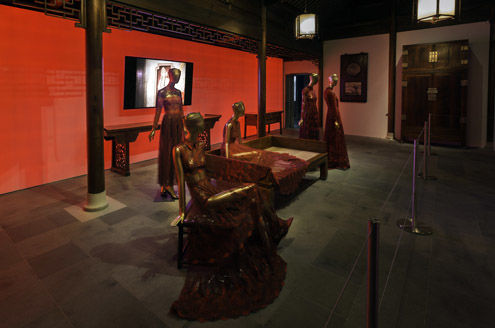
Ming Furniture
In Chinese culture, the color red, which traditionally corresponds to the element of fire, symbolizes good fortune and happiness. After the founding of the People's Republic of China in 1949, red also came to represent the communist revolution. In the West, the color is so strongly associated with China that it has come to stand in for the nation and its peoples. When Valentino presented its Manifesto collection in Shanghai in 2013, the creative directors Maria Grazia Chiuri and Pierpaolo Piccioli dedicated it to "the many shades of red." In choosing the color as the theme, they were also referencing the history of Valentino, as red has long been a signature color of the house. As early as the 1960s, its founder, Valentino Garavani, employed it throughout his collection, especially in his lavish evening designs. In this gallery are several gowns from the Manifesto collection, which epitomize the atelier's exquisite lacework and meticulous and magnificent embroideries.
Film and Music Presented in This Gallery
Raise the Red Lantern, 1991
Directed by Zhang Yimou
ERA International
Courtesy of ERA International
Farewell My Concubine, 1993
Directed by Chen Kaige
Miramax Films
Courtesy of Tomson Films
Mei Lanfang's Stage Art, 1955
China Film Archive
Courtesy of China Film Archive
Two Stage Sisters, 1964
Directed by Xie Jin
China Film Archive
Courtesy of China Film Archive
Incidental music from Two Stage Sisters
"The Drunken Beauty"
Performed by Mei Lanfang
"Farewell My Concubine Suite, Pt. 1," from Farewell My Concubine film score
Composed by Jiping Zhao
"Action 150," from The Grandmaster film score
Composed and performed by Nathaniel Mechaly, Traithep Wongpaiboon, Vichaya Vatanasapt
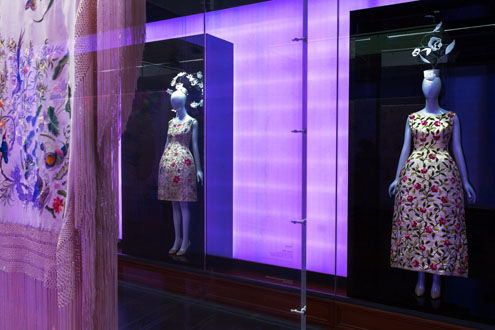
Export Silk
Ever since the silk trade between China and the Roman Empire blossomed in the late first and early second centuries, Western fashion's appetite for Chinese silk textiles has been insatiable. This craving intensified in the sixteenth century, when sea trade expanded the availability of Chinese luxury goods, giving rise in the seventeenth and eighteenth centuries to a lasting taste for chinoiserie (gallery 210).
In galleries 215 and 216 are examples of two textiles made for export—shawls and painted silks. Chinese export silks, like export wallpapers, have sometimes been subsumed into the history of the applied arts in the West. Yet despite their Western-inspired decoration, they remain part of the history of the material culture of China, particularly the port city of Canton (now Guangzhou). The relationship between producer and consumer, however, is complicated by the transmission of design elements between East and West. Like the sinuous motifs on the painted silks and wallpapers in these galleries, Chinese export art reveals multiple meanderings of influence from the earliest period of European contact with China, leading to the accumulation of layers and layers of stylistic translations and mistranslations.
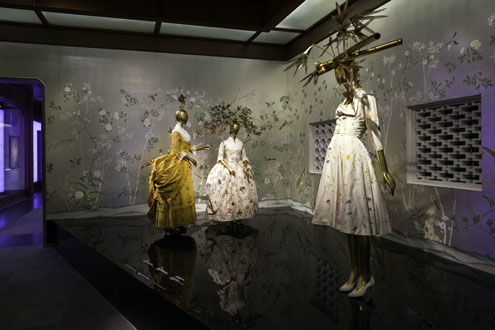
Music Presented in These Galleries
"Spring"
Composed and performed by Wu Tong
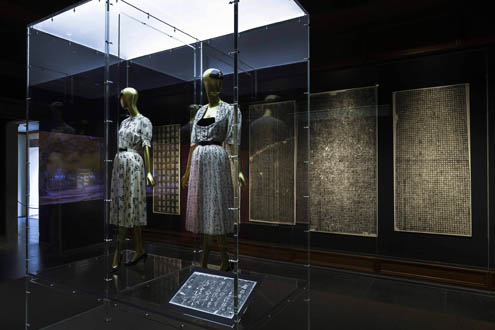
Calligraphy
Language can be a barrier or a gateway. It is therefore not surprising that Western fashion's abiding interest in Chinese aesthetics embraces the graphic language of calligraphy, which in China is considered the highest form of artistic expression. Designers are typically inspired by calligraphy for its decorative possibilities rather than its linguistic significance. Chinese characters serve as the textile patterns on the dresses by Christian Dior and Gabrielle "Coco" Chanel in this gallery. Because this language is seen as "exotic" or "foreign," it can be read as purely allusive decoration. Dior and Chanel were likely unaware of the semantic value of the words on their dresses, which in the case of Dior has resulted in a surprising and humorous juxtaposition. The dress is adorned with characters from an eighth-century letter by Zhang Xu in which the author complains about a painful stomachache. Language that constitutes communication, it would seem, is also capable of conveying miscommunication. Here, the letter is presented as a rubbing, as are the other calligraphic examples in the surrounding cases. Before photography, rubbings were the key technology for transmitting calligraphy across generations. Some of the greatest treasures of Chinese calligraphy, including the Letter on a Stomachache that inspired Dior, survive only through such impressions.
Film and Music Presented in This Gallery
Hero, 2002
Directed by Zhang Yimou
Miramax Films
Courtesy of EDKO FILMS LIMITED
"Gone with Leaves" and "Warriors," from Hero film score
Composed and performed by Tan Dun

Blue-and-White Porcelain
The story of blue-and-white porcelain encapsulates centuries of cultural exchange between East and West. Developed in Jingdezhen during the Yuan dynasty (1271–1368), blue-and-white porcelain was exported to Europe as early as the sixteenth century. As its popularity increased in the seventeenth and eighteenth centuries, in tandem with a growing taste for chinoiserie, potters in the Netherlands (Delft), Germany (Meissen), and England (Worcester) began to produce their own imitations. One of the most familiar examples is the Willow pattern, which usually depicts a landscape centered on a willow tree flanked by a large pagoda and a small bridge with three figures carrying various accoutrements. Made famous by the English potter Thomas Minton, founder of Thomas Minton & Sons in Stoke-on-Trent, Staffordshire, it was eventually mass- produced in Europe using the transfer-printing process. With the popularity of Willow-pattern porcelain, Chinese craftsmen began to produce their own hand-painted versions for export. Thus a design that came to be seen as typically Chinese was actually the product of various cultural exchanges between East and West.
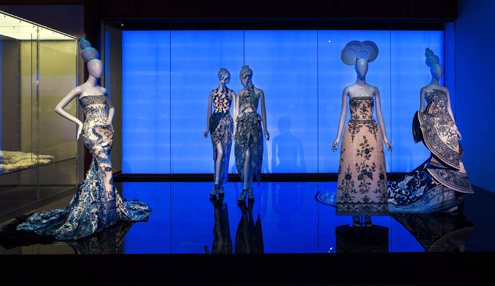
Music Presented in This Gallery
"Summer"
Composed and performed by Wu Tong
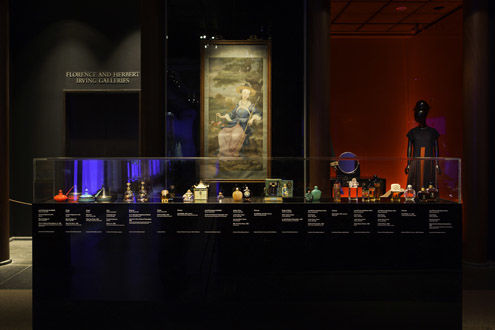
Perfume
Part of the power of perfume lies in its synesthetic possibilities, and the idea of China, confected from Western imagination, affords the perfumer a multiplicity of olfactory opportunities charged with the seductive mysteries of the East. Paul Poiret, famous for his fashions a la chinoise, was the first designer to produce a perfume fueled by the romance of China. Called Nuit de Chine, it was created in 1913 by Maurice Schaller and presented in a flacon inspired by Chinese snuff bottles designed by Georges Lepape, In the early 1920s, Poiret, excited by his dreams of Cathay, crafted several other perfumes, including orient and Sakya Mouni, both packaged in bottles inspired by Chinese seals. The 1910s and 1920s saw an influx of China-inflected perfumes, partly stimulated by the well-publicized archaeological excavations of the Mogao Caves in Dunhuang, Like Nuit de Chine, many were presented in flacons fashioned after Chinese snuff bottles, including Jean Patou's Joy, Roger & Gallet's Le Jade, and Henriette Gabilla's Pa-Ri-Ki-Ri, named after a musical revue starring Mistinguett and Maurice Chevalier. One of the more unusual flacons was created by the Callot Soeurs for the perfume La Fille du Roi de Chine. Shaped after a "lotus shoe" for a bound foot, it explicitly associated perfume, in Western eyes, with the exotic practice of foot-binding.
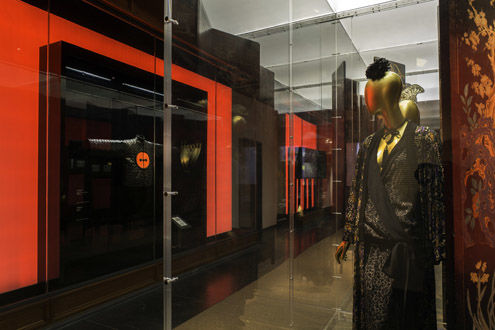
Saint Laurent & Opium
To this day, fashion's most flamboyant expression of chinoiserie is Yves Saint Laurent's extravagant fall/winter 1977 haute-couture collection. In a dazzling mélange of Chinese decorative elements, Saint Laurent reimagined Western ideas of Genghis Khan and his Mongol warriors and the imperial splendor of the Qing court under Dowager Empress Cixi (1835–1908). Of the collection, Saint Laurent commented, "I returned to an age of elegance and wealth. In many ways I returned to my own past." His designs merge authentic and imaginary elements of Chinese costume into a polyglot bazaar of postmodern amalgamation. Scallop patterns, pagoda shoulders, and frog and tassel closures are combined with conical hats and jade and cinnabar jewelry to convey a sumptuous, seductive impression of Chinese style as luxurious and glamorous as Paul Poiret's fantasies five decades earlier. The collection coincided with the launch of Saint Laurent's fragrance Opium, a name controversial even in the hedonistic 1970s because of its perceived endorsement of drug use; trivialization of the mid-nineteenth-century Opium Wars between China and Britain; and objectification of women through its highly sexualized advertisement photographed by Helmut Newton and featuring Jerry Hall. Setting the tone for the so-called power scents of the 1980s, the perfume is composed of myrrh, amber, jasmine, mandarin, and bergamot notes.
Chinoiserie

The idea of China reflected in the haute couture and avant-garde ready-to-wear fashions in this gallery is a fictional, fabulous invention, offering an alternate reality with a dreamlike, almost hallucinatory, illogic. This fanciful imagery, which combines Eastern and Western stylistic elements into an incredible pastiche, belongs to the tradition of chinoiserie (from the French chinois, meaning Chinese), a style that emerged in the late seventeenth century and reached its pinnacle in the mid-eighteenth century. China was a land outside the reach of most travelers in the latter century (and, for many others, still an imaginary land called "Cathay"), and chinoiserie presented a vision of the East as a place of mystery and romance. Stylistically, its main characteristics include Chinese figures, pagodas with sweeping roofs, and picturesque landscapes with elaborate pavilions, exotic birds, and flowering plants. Sometimes these motifs were copied directly from objects, especially lacquerware, but more often they originated in the designer's imagination. Chinoiserie's prescribed and restricted vocabulary directly produces its aesthetic power. That designers further elide the already reductive symbols of chinoiserie allows fashion to seductively and compellingly capture China's infinite complexities.

Film and Music Presented in This Gallery
Broken Blossoms, 1919
Directed by D. W. Griffith
D.W. Griffith Productions
Courtesy of Kino Lorber
Flowers of Shanghai, 1998
Directed by Hou Hsiao-Hsien
3H Productions and Shochiku Company
Courtesy of Shochiku Company
© 1998 Shochiku Co., Ltd.
Once Upon a Time in America, 1984
Directed by Sergio Leone
Warner Bros.
Courtesy of Warner Bros. Entertainment
The Grandmaster, 2013
Directed by Wong Kar Wai
Block 2 Pictures
Courtesy of Block 2 Pictures Inc.
© 2013 Block 2 Pictures Inc. All rights reserved.
Ziegfeld Follies, 1946
Directed by Vincente Minelli
Metro-Goldwyn-Mayer
Courtesy of Warner Bros. Entertainment Inc.
"Action 150," from The Grandmaster film score
Composed and performed by Nathaniel Mechaly, Traithep Wongpaiboon, Vichaya Vatanasapt
Ancient China

China's varied and vibrant artistic traditions have served as sources of continuous invention and reinvention for Western fashion. Works of art from the seventeenth century onward resonate most strongly with designers. As this gallery and the adjacent gallery (207) reveal, however, designers have also found inspiration in earlier forms, including Neolithic pottery, Shang-dynasty bronzes, Tang-dynasty mirrors, Han-dynasty tomb figurines and architectural models, early Buddhist sculpture and iconography, and ancient Chinese literature, including wuxfa. These cross-cultural comparisons, as with others in the show, have an appeal that rests on their clarity and legibility that is, on one's ability to decode the motifs and stylistic references. The comparisons demonstrate how the creative process is inherently transformative, a phenomenon seen here in works of art that boldly reduce a complex matrix of meanings into graphic signs that say "China" not as literal copies but as explicit allusions to a prototype.
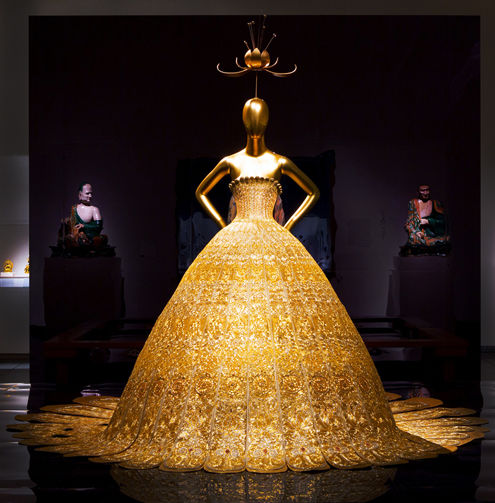
Guo Pei
Like their Western counterparts, Chinese designers frequently find inspiration in the aesthetic and cultural traditions of the East. Paradoxically, they often gravitate toward the same motifs and imagery. While it is important to distinguish between internal and external views of the East, such affinities support, at least in fashion, a unified language of shared signs. In this dress by the Chinese designer Guo Pei, Buddhist iconography provides the primary source of inspiration. The bodice is shaped like a lotus flower, which is one of the eight Buddhist symbols and represents spiritual purity and enlightenment. The motif is also embroidered onto the skirt. In an act of Occidentalism, the shape of the skirt, which has no archetypes in Eastern dress traditions, is based on the inflated crinoline silhouette that emerged as modish apparel in the West in the 1850s. As with the Western designers in this exhibition, Guo Pei does not practice an exoticism of replication but rather one of assimilation, combining Eastern and Western elements into a common cultural language.
Music Presented in This Gallery
"Winter"
Composed and performed by Wu Tong
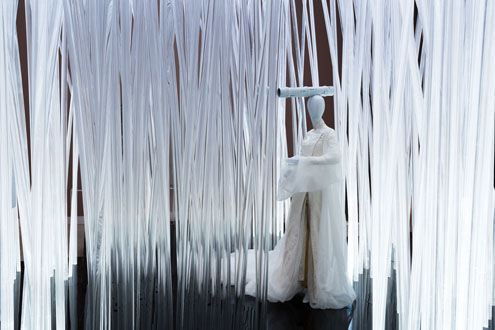
Wuxia
For many Western designers, some of the most compelling fantasies of China are in wuxia, a literary genre that is more than two thousand years old. Wuxia, which roughly translates as "martial hero," relates the adventures of wandering swordsmen whose martial-arts skills are so highly developed that they can internalize their qi (life force) and unleash such superhuman powers as "thunder palms," "shout weapons," and "weightless leaps." The stories often take place in an underworld calledjiang hu (rivers and lakes), in which martial artists cohabit with monks, bandits, and burglars. The heroes are governed by xia, a strict code of chivalry, whose common attributes include justice, honesty, benevolence, and a disregard for wealth and desire. Such traits have led many wuxia novels to be read as expositions on Buddhism, an association played out in this gallery, which displays some of the Museum's earliest examples of Chinese Buddhist art.
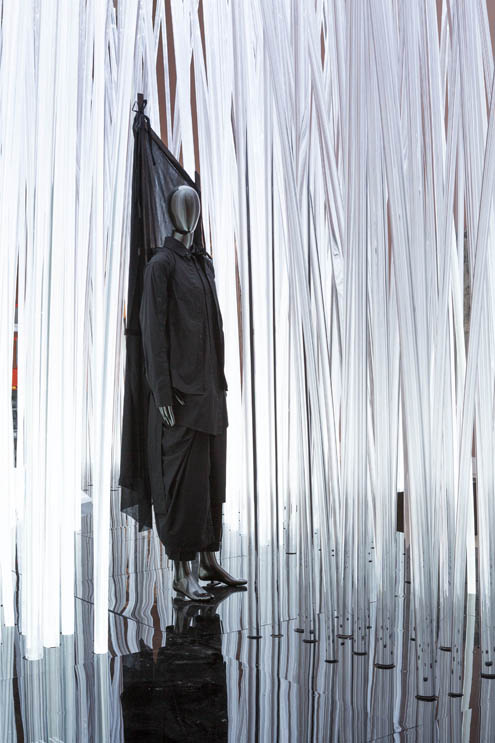
Film and Music Presented in This Gallery
House of Flying Daggers, 2004
Directed by Zhang Yimou
Sony Pictures Classics
Courtesy of EDKO FILMS LIMITED
A Touch of Zen, 1971
Directed by King Hu
International Film Company and Union Film Company
Courtesy of Taiwan Film Institute
"The Echo Game" and "The House of Flying Daggers," from House of Flying Daggers
film score
Written by Shigeru Umebayashi
Roberto Cavalli (Italian, born 1940). Evening dress, fall/winter 2005–6. Photograph © Platon